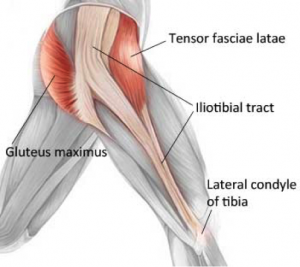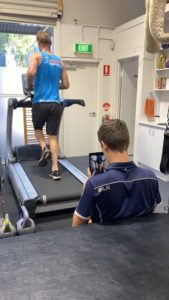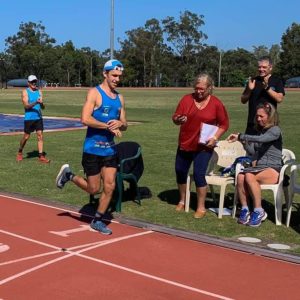Has ITB pain been stopping you from running?
By running Physio, Kyle Weise
 You’re running along and then “ouch”, you suddenly have a pain in the side of your knee! You try to keep running but the pain really is so unbearable that you have to stop and walk.
You’re running along and then “ouch”, you suddenly have a pain in the side of your knee! You try to keep running but the pain really is so unbearable that you have to stop and walk.
Has this happened to you?
If so, you are not alone, ITB pain is one of the most prevalent running related injuries, accounting for between 5-14% of all running related injuries. ITB pain is one of the only running related injuries that will stop you in your tracks and have you phoning for a lift home, it’s not a fun pain to experience.
 There are a lot of common misconceptions regarding ITB pain and how to manage it, so I’m going to discuss what the research currently tells us about this injury. Let’s start with what the ITB is and why do runners get it?
There are a lot of common misconceptions regarding ITB pain and how to manage it, so I’m going to discuss what the research currently tells us about this injury. Let’s start with what the ITB is and why do runners get it?
- The ITB is thought to function as a strut during walking, acting as both a hip and a knee stabiliser. It stores considerable magnitudes of elastic energy during walking & running. During running, it stores and releases the second most energy (5-8%) behind the achilles tendon (35-40%).
- The ITB provides lateral (outside knee) reinforcement at your knee joint and provides also reinforcement against tensile (tension) loading on the outside aspect of the femur.
- Historically, ITB pain was considered a friction (rubbing) injury. However, a new theory has developed more recently with the help of magnetic resonance imaging (MRI) showing that when the knee is flexed past 30°, the band compresses medially against the lateral knee. This compression is theorised to cause irritation of the highly innervated fat pad between the band and the bone, strongly suggesting that ITB pain should be classified as a compression syndrome.
- A commonly held belief within running circles is that ITB pain is caused by a “tight ITB”. There is no evidence to support that ITB pain is caused by a “tight ITB”. In fact, a study which measured the “tightness” of the ITB, showed that as runners recovered from ITB pain, their ITB became stiffer!
So how do you know if you have ITB pain?
- You will experience lateral (outside) knee pain approximately 2–3 cm above the crease on the outside of your knee joint
- The onset of pain is often insidious in nature (seems like there is no cause), but on reflection will likely be preceded by a recent spike in running loads, usually consisting of an increased running distance, or increased volume of downhill running.
- Running, particularly downhill or fast running, are most likely the biggest exacerbators of symptoms
What factors contribute to ITB pain?
- Multiple research papers have found that individuals who would go on to develop ITBS (ITB syndrome) exhibited greater hip adduction (that is, their thigh angling inwards in standing) and knee inwards rotation during running when compared with matched controls. Think of this as your foot landing across the middle of your body.
- Sudden increase in running related loads:
– Downhill running
– Speed sessions
– Narrow (single trail) running
What can you do about ITBS?
Current research for management strategies shows only low quality evidence with a large amount of conflicting results.
What is agreed upon is that a progressive overload and graded exposure to increasingly challenging activities are consistently described as integral to the recovery of runners with ITB pain.
So what can you do if you are experiencing ITB pain?
Firstly and most importantly, rarely can a runner continue to run through ITB pain and have it get better, so you need to reduce and find a pain free level of running:
- You may even need to walk, use the cross-trainer or try the Alter-G Treadmill
- If you can run, avoid downhill running and speed work
- You may find running at a 5-7% incline on a treadmill will be ok
- or even use uphill treadmill walking at steeper inclines (10% incline)
 Strength training:
Strength training:
– Progress overload of the ITB itself through heavy strength resistance exercise followed by plyometric (jumping and landing) loading. This should be directed by a Physio or strength & conditioning Coach that understands running so you don’t end up with other injuries- Run Technique retraining:
– Try running with a wider step width to reduce ITB strain
– Running with a higher cadence (stride frequency) will also reduce ITB strain and strain rate and reducing stride reaching with your foot overstriding will also change the angle of the knee joint (Our Physio’s can review your current run technique and give you drills and exercise to improve technique) - Once you are back running, come in for a Running Assessment so we can review your running and improve both your technique and your performance and reduce risk of another occurrence
 There are a number of other variables that will need to be assessed to determine the best pathway forward if you are experiencing ITB pain by your Physio.
There are a number of other variables that will need to be assessed to determine the best pathway forward if you are experiencing ITB pain by your Physio.
So, if you or someone you know has been struggling to run due to ITB pain, our experienced team of Physio’s understand running and are able to provide an individualised plan for you to ensure you are able to return to enjoying your running once again!
phone 07 55006470 for an appointment or Book Online www.mygcphysio.com.au
